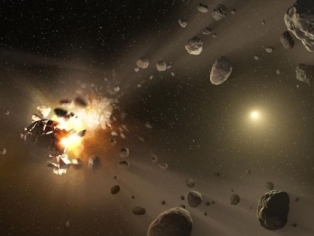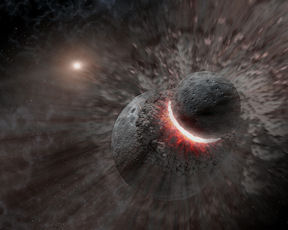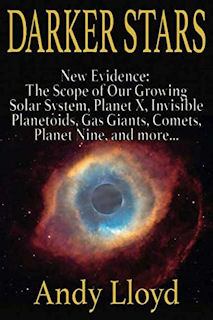Andy Lloyd's Dark Star Blog

Blog 91 (October - December 2022)
Rare Metals Hint at 'Celestial Battle'

When writing a non-fiction book in popular science, you hope that you cover all the available ground before publishing. It's next to impossible to achieve this when writing across the swathe of disciplines that make up the Dark Star research. There will always be something which pops up after the fact. This particular news piece came out in 2018 (1). I do wish I'd seen it back then - it would definitely have found its way into Darker Stars (2)! My friend and colleague Lee Covino dug this out recently - it fits well with the Sitchin-themed view of the origin of our Earth.
We both 'believe' that the Earth started out where the asteroid belt is now. This view is based upon our readings of Zecharia Sitchin, who offered a rather quirky interpretation of our solar system's cosmology based upon ancient Mesopotamian texts (3). He argued that ancient cosmology placed the Earth between Mars and Jupiter until it was knocked out of place by a usurper planet, often known as Nibiru (or Planet X).
I enjoy the challenge this idea offers to mainstream thinking. In the many years I've written about this, astrophysical theories have progressed - as science does - and the idea of planetary migration has become much more acceptable. The Nice Model has it that the great planets in our system jostled backwards and forwards as the primordial dust and gas disk dissipated (4). In recent blogs, I've highlighted current thinking about an further inward migration of planetessimals in the inner solar system (5). This drift of materials (still laden with water ice) then formed the inner planets.
Lee and I go further. We think the Earth initially formed about 4AU away, was impacted early on by a neighbouring planet (astronomers call this Mars-sized impactor 'Theia') to form the Moon (Sitchin's 'Kingu'), and was later knocked out of its orbit by a rogue planet (Sitchin's Nibiru/Marduk). It migrated inwards to its current position and the rogue planet was tossed out into the fringes of the outer solar system ('Planet X'). The debris from the collision formed the asteroid belt.
Interestingly, according to recent computer simulations of the 'Theia' collision (6), the Moon may have formed within just a few hours:
"Most theories claim the Moon formed out of the debris of a collision between the Earth and an object about the size of Mars, called Theia, coalescing in orbit over months or years. A new simulation puts forth a different theory - the Moon may have formed immediately, in a matter of hours, when material from the Earth and Theia was launched directly into orbit after the impact." (8)
That little nugget aside, the jigsaw of what bit of the solar system came from where relies upon forensic examination of chemicals and metals on planets, moons, asteroids and comets. It's not just their relative composition, but also the isotopic constituency of the elements in the different bodies. Sometimes there's a match, sometimes not. The outer belt asteroids and Earth share the same watery fingerprints, for instance. Which is kind of weird. Everyone expected the comets to be the bringers of Earth's water.
In the 2018 piece I mentioned earlier, it's rare metals in the planetary mantle that take centre stage. The work is predominantly about Mars and the impacts it seems to have suffered early in its history. But there's also some discussion of Earth, in a similar vein. It turns out there is an over-abundance of rare metals in the Earth's mantle which, according to theory, should mostly have drifted inwards to the core (these metals are 'siderophiles' and like hanging out with iron) (8).

Their significant presence in the Earth's mantle implies that they arrived after the core and mantle separated. Presumably, they arrived late, via impact/s (8). Their relative abundance represents a late 'veneer' of rare metals in the Earth's mantle.
"...Earth has more siderophiles in the mantle than it should... The scientists explained this by showing that an impact of a lunar-sized body on the Earth (in addition to the event that formed the moon) would have enriched the mantle with enough siderophiles to explain the current value." (1)
What is really interesting is that these scientists are talking about a second early impact - in addition to the impact that formed the Moon.
The second impact event described here opens the
door to Sitchin's Nibiru/Marduk event.
This is because 'Kingu' (or the Moon) may already
have been in place at that time, following the Theia
impact. If the Earth was in the asteroid belt
location with the Moon already orbiting it, and it
was then hit by another small planet or large moon (Marduk's
'North Wind' in Sitchin's account (7)), then that
colossal impact could have triggered Earth's inwards
migration. After all, Sitchin's rogue planet was
sizeable and, therefore, capable of 'perturbing' the
Earth's orbit during that encounter.
I rather wish I had read this article before
completing 'Darker Stars' (8). Although it
isn't a smoking
gun, the evidence for a second massive
planetary-scale impact on the early Earth does sit
rather nicely with Sitchin's 'Celestial Battle'.
If true, then the rare metals in the Earth's mantle
originally came from interstellar space.
Written by Andy Lloyd, 6th October 2022
References:
1) Amanda Doyle 'Rare Metals On Mars And Earth Implicate Colossal Impacts' 23 March 2018 with thanks to Lee
2) Andy Lloyd "Darker Stars" Timeless Voyager Press 2019
3) Zecharia Sitchin "The Twelfth Planet" Avon 1976
4) Sean Raymond 'The giant planet instability (the “Nice model”)'
5) Andy Lloyd "Earth's Inward Migration" 30th June 2022
andylloyd.org/darkstarblog89.htm
6) J. Kegerreis et al. 'Immediate Origin of the Moon as a Post-impact Satellite'. The Astrophysical Journal Letters, 2022; 937 (2): L40
7) NASA/Ames Research Center 'Collision may have formed the Moon in mere hours, simulations reveal' 4 October 2022
8) R. Brasser & S. Mojzsis 'A colossal impact enriched Mars' mantle with noble metals' Geophysical Research Letters, 44, 5978–5985, 6 June 2017
9) R. Brasser et al. 'Late veneer and late accretion to the terrestrial planets', Earth Planet. Sci. Lett., 455, 85–93, December 2016
sciencedirect.com/science/article
A Mirror Dark Planet?
Could Planet X be made up of Dark Matter? It turns out that Dark Matter planets might just be a thing. Composed of condensed and cooled dark matter, such enigmatic worlds would not interact with light, or even normal stuff (which would pass right through them). What they would do is provide a gravitational effect (1). The physics of this speculative concept is somewhat beyond me, dear reader, but there are Idiot's Guides available (2).
So, a planet which cannot be seen or touched, but which exudes a significant gravitational effect. What does that remind you of? It was only a matter of time before two speculative fields in astrophysics collided. A group of Chinese researchers have written a paper on whether Planet Nine is 'dark':
"Here, we discuss the possibility of a mirror planet acting as the P9 which is formed by mirror dark matter, another possible dark matter candidate. In this scenario, the mirror sector is the exact copy of the standard model sector... The non-gravitational interactions between the two sectors are negligible, such that the mirror part could constitute the non-baryonic dark matter in the universe. However, the mirror particles hold the same interactions as the ordinary parts, which predict a similar structure such as dark stars, dark neutron stars, and even dark planets...
"If the P9 is completely a mirror planet, only gravitation effects, such as microlensing and time delay, are expected to be observed. This dark planet ... reflects sunlight as it accretes ordinary matter from the environment." (3)
Although the dark P9 world would not be composed of material that interacts with neither the electromagnetic spectrum nor electrostatic forces, it isn't itself very observable. But its gravity will coalesce material around it (rather like an invisible man putting on clothes) which could be observed and interacted with, albeit more faintly than regular matter. Such a world may have been captured by our Sun into a wide Planet X-style orbit, the Chinese researcher argue.
Written by Andy Lloyd, 6th December 2022
References:
1) John Wenz "Dark Matter Might Clump to Form Planets" 14 July 2017
discovermagazine.com/the-sciences/dark-matter-might-clump-to-form-planets
2) Matt Buckley "Paper Explainer: Collapsed Dark Matter Structures" 13 July 2017
physicsmatt.com/blog/2017/7/13
2) Wang P. et al. "The Possibility of Mirror Planet as Planet Nine in Solar System" 9 Oct 2022, draft paper


